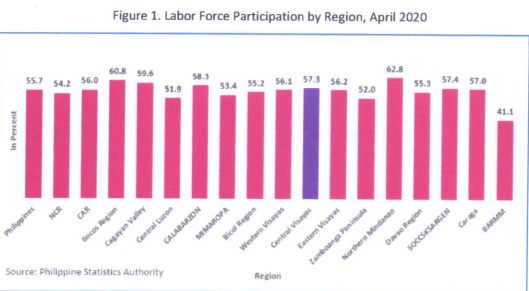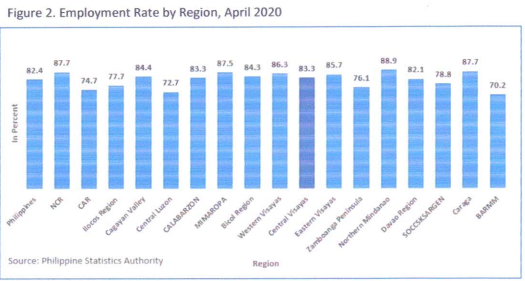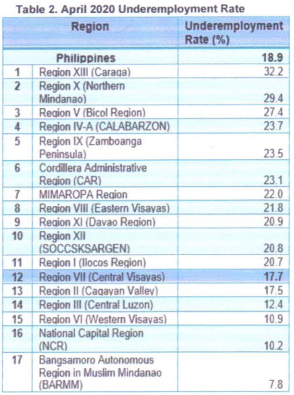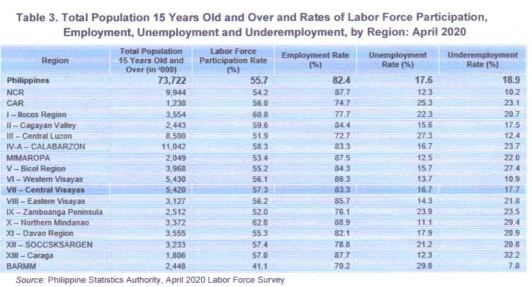Fifty-seven Percent of the population 15 years old and over are in the labor force
In April 2020, the total population 15 years old and over in Central Visayas was estimated at 5.4 million wherein the number of persons who were in the labor force was reported at 3.1 million. This placed the labor force participation rate (LFPR) at 57.3 percent, which means that six in ten of the population aged 15 years and over were either employed or unemployed. (Figure 1)

Central Visayas recorded an 83.3 percent employment rate
The total number of employed persons in Central Visayas was estimated at 2.6 million. The employment rate reported or the proportion of employed persons to total labor force was 83.3 percent (Figure 2).

Central Visayas had a higher employment rate than the national employment rate of 82.4 percent in April 2020.
Meanwhile unemployed persons include all those who, during the reference period, are 15 years old and over as of their last birthday who have no job/business, currently available for work and actively looking for work.
Also considered as unemployed are persons without a job or business who are reported not looking for work because of their belief that no work was available or because of temporary illness/disability, bad weather, pending job application or waiting for job interview.
Table 1 shows the national unemployment rate in April 2020 was estimated at 17.6 percent. The table also shows that there were 7 regions which have an unemployment rate higher than the Region VII figure.
By definition, employed persons who express desire to have additional hours of work in their present job, or to have additional job, or to have a new job with longer working hours are considered underemployed.
In April 2020, the underemployment rate was estimated at 17.7 percent for Central Visayas (Table 2)

and ranked 12th among regions.
Underemployed persons who work for less than 40 hours in a week are called visibly underemployed persons.
The April 2020 Employment Situation is taken from the final result of the April 2020 Labor Force Survey conducted by the Philippine Statistics Authority (Table 3).

TECHNICAL NOTES
The Labor Force Survey (LFS) is a nationwide quarterly survey conducted by the Philippine Statistics Authority (PSA) during the months of January, April, July, and October. For this release, the data being presented are based on the final results of the April 2020 round of the LFS.
The reference period used in the survey is the past seven (7) days preceding the date of interview of the enumerator.
The concepts and definitions used in the survey can be found in PSA Integrated Survey of Households (ISH) Bulletins. Some are given below:
a. Labor Force – refers to the population 15 years old and over who contribute to the production of goods and services in the country. It comprises the employed and unemployed.
b. Employed – refers to persons in the labor force who are reported either as at work or with a job or business although not at work. Persons at work are those who did some work, even for an hour during the reference period.
c. Unemployed – refers to persons in the labor force who are reported as:
1. without work;
2. currently available for work; and
3. seeking work or not seeking work due to the following reasons:
i. ECQ/Lockdown/COVID-19 pandemic;
ii. Belief that no work is available;
iii. Awaiting results of previous job application;
iv. Because of temporary illness or disability;
v. Bad weather; or
vi. Waiting for rehire or job recall.
d. Underemployed – refers to employed persons who express the desire to have additional hours of work in their present job or an additional job, or a new job with longer working hours.
e. Labor Force Participation Rate (LFPR) – refers to the proportion of total labor force to the total household population 15 years old and over.
f. Employment Rate – refers to the proportion of employed persons to the total labor force.
g. Unemployment Rate – refers to the proportion of unemployed persons to the total labor force.
h. Underemployment Rate – refers to the proportion of underemployed persons to total employed persons.
1. Starting January 2012 LFS, the codes for industry adopted the 2009 Philippine Standard Industrial Classification (PSIC). Prior to this, codes for industry used the 1994 PSIC.
2. Question on vocational course was introduced in the April 2012 Labor Force Survey (LFS) questionnaire.
3. Starting April 2016 round, the LFS adopted the 2013 Master Sample Design, with a sample size of approximately 44,000 households.
4. The 2012 Philippine Standard Occupational Classification (PSOC) was adopted starting April 2016. The 1992 PSOC had been used prior to April 2016.
5. Starting with the April 2016 LFS round, the population projections based on the 2010 Census of Population and Housing (2010 CPH) has been adopted to generate the labor force statistics.
6. In July 2016, the 2008 Philippine Standard Classification of Education (PSCED) that was used in the 2015 Population Census (2015 POPCEN) has been adopted. The categories in highest grade completed were also revised considering the K-12 program in the education system.
7. In April 2017 round, Computer Aided Personal Interviewing (CAPI) using Tablet was utilized in the LFS enumeration.
8. Overseas Filipino Workers (OFWs) are not considered as part of the labor force in the Philippines. Hence, in the LFS, data on economic characteristics of household members who are OFWs are not collected. For the LFS reports, they are excluded in the estimation of the size of working population, that is, population aged 15 years and older, and in the estimation of the labor force.
9. Starting with the January 2020 LFS round, the population projections based on the 2015 Population Census (POPCEN 2015) have been adopted to generate the labor force statistics. For comparability, population projections based on the POPCEN 2015 were likewise used in the April 2019 labor force statistics.
10. For the April 2020 round, ECQ/Lockdown/COVID-19 pandemic was included in the reasons for working more than 48 hours, less than 40 hours, and not looking for work. The April 2020 LFS was conducted from 20 April to 16 May 2020.
Approved by:
(SGD.) ARIEL E. FLORENDO
Regional Director

